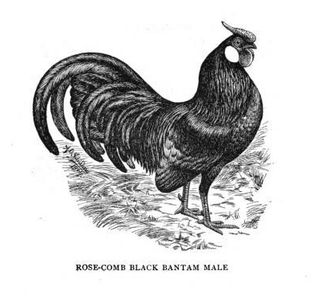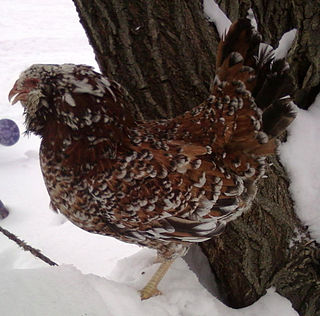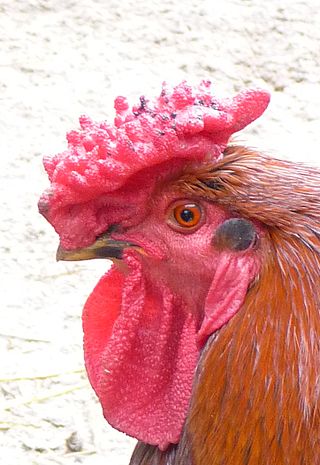
The American Game is an American breed of game fowl, chickens bred specifically for cockfighting. It has many color varieties, and may also be kept for ornament.

A comb is a fleshy growth or crest on the top of the head of some gallinaceous birds, such as domestic chickens. The alternative name cockscomb reflects the fact that combs are generally larger on cock birds than on hens. The comb is one of several fleshy protuberances on the heads of chickens, the others being the wattles and earlobes, which collectively are called caruncles. In turkeys, the caruncles are the fleshy nodules on the head and throat.

The Sussex is a British breed of dual-purpose chicken, reared both for its meat and for its eggs. Eight colours are recognised for both standard-sized and bantam fowl. A breed association, the Sussex Breed Club, was organised in 1903.

The Japanese Bantam or Chabo is a Japanese breed of ornamental chicken. It is a true bantam breed, meaning that it has no large fowl counterpart. It characterised by very short legs and a large upright tail that reaches much higher than the head of the bird.

The Rosecomb is a breed of chicken named for its distinctive comb. Rosecombs are bantam chickens, and are among those known as true bantams, meaning they are not a miniaturised version of a large fowl. Rosecombs are one of the oldest and most popular bantam breeds in showing, and thus have numerous variations within the breed. An ornamental chicken, they are poor egg layers and not suited for meat production.

The Sebright is a British breed of bantam chicken. It is a true bantam – a miniature bird with no corresponding large version – and is one of the oldest recorded British bantam breeds. It is named after Sir John Saunders Sebright, who created it as an ornamental breed by selective breeding in the early nineteenth century.

The Houdan or Poule de Houdan is an old French breed of domestic chicken. It is named for its area of origin, the commune of Houdan, in the département of Yvelines to the west of Paris. It belongs to the crested chicken group, is muffed and bearded, has an unusual leaf-shaped comb, and has five toes on each foot rather than the usual four.

The Dutch Bantam is a breed of bantam chicken originating in the Netherlands. It is a true bantam, a naturally small bird with no related large fowl from which it was miniaturized. It is kept mainly for exhibition, and has been bred in many color varieties; it is a good layer of small eggs.
The Nankin Bantam or Nankin is a British bantam breed of chicken. It is a true bantam, a naturally small breed with no large counterpart from which it was miniaturised. It is of South-east Asian origin, and is among the oldest bantam breeds. It is a yellowish buff colour, and the name is thought to derive from the colour of nankeen cotton from China.

The Rhode Island White is a breed of chicken originating in the U.S. state of Rhode Island. Despite their very similar names and shared place of origin, the Rhode Island White is a distinct breed from the Rhode Island Red. However, Rhode Island Reds and Whites can be bred together to create Red Sex-Link hybrid chickens, such as the ISA Brown. In Australia, the Rhode Island White is regarded as a color variety of the Rhode Island breed according to the Australian Poultry Standards.

The Delaware is a breed of chicken originating in the U.S. state of Delaware. It was once of relative importance to the U.S. chicken industry, but today is critically endangered. It is primarily suited to meat production but also lays reasonably well. It has plumage of a unique pattern, and is accepted into poultry standards for showing.

The Java is a breed of chicken originating in the United States. Despite the breed's name, a reference to the island of Java, it was developed in the U.S. from chickens of unknown Asian extraction. It is one of the oldest American chickens, forming the basis for many other breeds, but is critically endangered today. Javas are large birds with a sturdy appearance. They are hardy, and are well-suited for both meat and egg production, especially by small-scale farms, homesteads, and backyard keepers.
The Iowa Blue is a breed of chicken that originated near Decorah, Iowa, in the early twentieth century. Despite its name, the breed is not actually blue according to poultry standards. It is an exceedingly rare fowl, and is not recognized for showing by the American Poultry Association. They are a dual-purpose breed laying brown eggs and known to be good foragers.

The Orloff is a breed of chicken named after Alexei Grigoryevich Orlov, a Russian Count. Reflecting this origin, it is sometimes called the Russian Orloff or simply Russian.

The Derbyshire Redcap is a breed of chicken originating in the English county of Derbyshire. The name "Redcap" derives from the breed's unusually large Rose-type comb. British breed standards dictate a length of more than 7 centimetres (3 inches) of length for a Redcap comb. It is covered in small, fleshy points, and has a distinct spike pointing backwards called a "leader". Combs, wattles and earlobes are all ideally bright red.

The Scots Grey is a dual-purpose breed of domestic chicken originating in Scotland, where it has been bred for more than two hundred years. It was formerly known as the Scotch Grey and until about 1930 was popular in Scotland. It is on the "Native Poultry Breeds at Risk" list of the Rare Breeds Survival Trust.

The Vorwerk is a breed of chicken originating in Germany. Though it is unrelated to the German company which produces the Vorwerk vacuum cleaner, it is the only chicken to share its name with a brand of household appliance. A rare fowl, it has distinctive black-and-gold plumage.

Broodiness is the action or behavioral tendency to sit on a clutch of eggs to incubate them, often requiring the non-expression of many other behaviors including feeding and drinking. Being broody has been defined as "Being in a state of readiness to brood eggs that is characterized by cessation of laying and by marked changes in behavior and physiology". Broodiness is usually associated with female birds, although males of some bird species become broody and some non-avian animals also show broodiness.
Ginseng chicken soup is a type of soup, which involves chicken and ginseng as one of the main ingredients. Ginseng can typically be cooked with chicken in broth, porridge, and soups. Varieties of ginseng chicken soup can be found in Asian countries, such as China, Malaysia, and Korea.





















